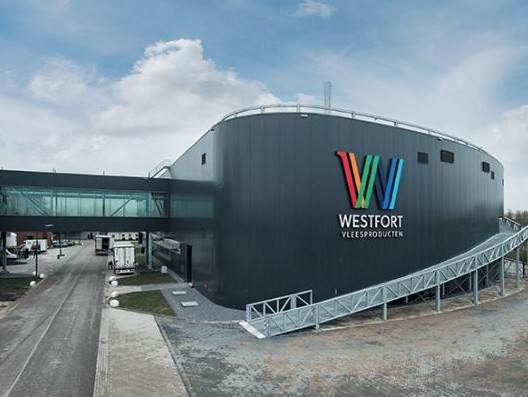
In 2016, Westfort Vleesproducten, member of the Netherlands’ Central Organisation for the Meat Sector (COV), welcomed hundreds of visitors to its new slaughterhouse in IJsselstein (Utrecht).
In its innovative slaughterhouse, Westfort has invested in animal welfare, improved meat quality and sustainable energy solutions. The company has said that it is aiming for complete transparency in its approach, which is why space has been created for ‘skyboxes’ from where visitors can observe every process. Furthermore, the company has installed CCTV cameras inside the slaughterhouse that monitor the entire production process 24/7. We published an interview with the director of this innovative company in February 2016, and you can read the highlights of that interview here [link].
“Thanks to the innovative fermentation unit we have reduced our waste from 75 tons a day to just 5 tons,” adds Jaap de Wit proudly. “And because the unit is located on our own premises, this also considerably reduces the transport of waste products. We’ve decreased our transport activities from 3 trucks a day to just one a week!” Once Jaap starts explaining how the unit works and its possibilities, there’s no stopping him. He continues enthusiastically: “The sludge from the water purification process is carried to the fermentation unit. The methane gas produces in the fermentation process is burned in the thermal power plant. The fermentation unit generates an impressive 20% of the electricity we use and 80% of our thermal input. In addition it converts the waste flows into natural fertilisers.”
Westfort works with several different and distinct pork concepts. Each batch of pigs that arrives at the slaughterhouse is kept strictly separate. As soon as they are unloaded, the animals are immediately colour-coded and remain so throughout all stages of the production process – from arrival and anaesthesia to the deboning and packaging departments. “All our pigs are born and raised on Dutch farms. We know exactly where all of them have come from, which feed mix supplier each farmer works with and even which vet. So if there’s been a problem upstream in the chain, we can take immediate action.”
“Because we place high demands on animal welfare in northern Europe we went in search of a way of minimising the stress for the animals, from the moment they arrive and during their stay until the moment they are anaesthetised,” explains Rob Lunenburg. “As a result, we opted for four unloading areas, even though three would have been enough based on our capacity. The rest areas have heated flooring so that the animals don’t become cold and stiff. We also use a completely new anaesthesia method,” continues Rob Lunenburg. “It’s based on anaesthesia lifts. They each work independently so if there’s a technical problem with one of the lifts, the other three offer sufficient capacity for us to maintain the required slaughtering rhythm. The air in the lifts automatically drops to the optimal CO₂ concentration. Unlike with traditional systems, we can visually monitor this entire process.” The system has been developed in collaboration with MPS.
Around 700 farmers as well as representatives from the media, the government, NGOs, local residents and other businesses from all over the world have already taken a tour of the company, according to the annual report by KDV, the sustainable pork value chain concept in which Westfort plays an active role. At the end of 2016, members of COV also had the opportunity to visit the company during the COV General Meeting. Westfort is proud to have received so much positive feedback, including attracting special attention from ‘intern’ and columnist Arnon Grunberg in Dutch newspaper NRC Handelsblad and blogs by Bert van den Berg from the Dutch Animal Protection Society following a visit to the slaughterhouse.
Source: © Westfort